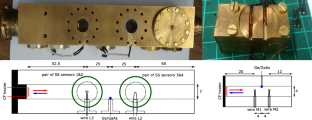Vibrating Microwire Resonators Used as Local Probes of Quantum Turbulence in Superfluid \(^{4}\)He
Abstract
We report the use of a 60 \(\upmu\)m thick superconducting NbTi vibrating wire resonator as a local probe of quantum turbulence in superfluid \(^{4}\)He (He II). Wire resonance is driven via magneto-motive force, exclusively in the laminar hydrodynamic regime. For the detection of quantized vortices, changes in the probe resonant frequency and peak amplitude are measured in reaction to the applied external counterflow. Calibration of the device response is obtained in thermal counterflow in the temperature range from 1.45 to 2.1 K against second sound attenuation data. The main motivation of this work is the development of local probes of quantum turbulence suitable for use in non-homogeneous systems such as flows with spherical or cylindrical symmetry. The frequency response of the devices is described with good accuracy at lower temperatures by considering the balance between viscosity and mutual friction and its effect on the boundary layer. Under the experimental conditions, the fluid–structure interaction cannot be modeled reliably by an effective turbulent viscosity and agrees better with a model of the boundary layer modified by mutual friction. The obtained results may be extended to the interaction of nanoscale devices with sufficiently dense vortex tangles.


 求助内容:
求助内容: 应助结果提醒方式:
应助结果提醒方式:


